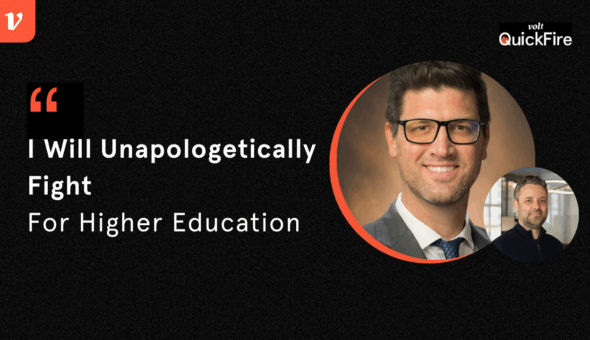Colleges and universities are increasingly reliant on social media as an admissions recruitment tool. However, recent developments among the platforms have ensured that its use isn’t as straightforward as some might like it to be.
The growing usage of TikTok, instability at Twitter, use of artificial intelligence and introduction of Threads are only a few of the changes higher ed marketers must navigate.
All these disruptions are causing institutions to reassess their approaches when it comes to social media.
Disruptions at X
Changes at Twitter, which now goes by X as of late July, seem to be a constant occurrence since Elon Musk acquired the platform in 2022.
The prestige of the blue checkmark, a verification held by many academics and institutions, was wiped away in April. Now, anyone with a Twitter Blue subscription could obtain the checkmark.
At the beginning of July, Musk announced that verified accounts would be limited to reading 6,000 posts per day. Unverified accounts can only view 600 posts per day. According to Musk, the limits are to “address extreme levels of data scraping & system manipulation.”
Information from the Pew Research Center indicates the recent changes at X are impacting the way users interact with the platform. Notably, a spring 2023 survey showed that a quarter of current and recent platform users “said it is unlikely they will be on the site a year later.”
Did Higher Ed Institutions Leave X?
According to industry insiders, it’s difficult to say definitively if institutions are getting off X. Institutions may not be issuing press releases noting the deletion of their accounts, but the ones that now view the platform with skepticism are likely quietly disengaging.
“I think everyone is keeping their eye on it and waiting to make a decision,” Michael McGetrick, vice president at higher education marketing firm Spark451 and adjunct faculty in the New York University Tandon School of Engineering, said about the decision to get off X. “I don’t think anyone has made any statements or has been very open about what they’ve been doing with Twitter and their advertising.”
Although the platform hasn’t been very effective for advertising, he added, some of the institutions he works with have asked to stop what few dollars they have been spending there.
“Twitter has mostly been for pushing out information. There has been some advertising on it, but not a lot,” said Ardis Kadiu, founder and CEO of the comprehensive higher education platform Element451. “It’s seen as a feed instead of a conversation. I would say there are few schools that do it well in terms of being on Twitter. Lately, it’s become a lot more visual but the primary content there is text-based so it’s really seen as a channel for updates and a newsfeed.”
McGetrick agrees, noting that he views the platform as being a news channel that institutions use to get the word out about various announcements.
“It’s not the place for rational discussion and engagement for students,” he said.
Dr. J.C. Bonilla is the global chief analytics officer for VaynerMedia, a creative and media agency, and adjunct faculty of analytics at New York University. “In my opinion, a prospective student in their late teens and early 20s is not on Twitter, so it’s not an audience that’s over-indexing there,” he said.
Aside from that, Bonilla asserted, higher education never was all that good at using Twitter due to its character limits. “We need too much disclosure to talk about how grandiose my cafeteria, my research, my academic lab is,” he said.
Academics Are Leaving.
What’s clearer, however, is that some academics are leaving the platform.
Dr. Mark Carrigan is a digital sociologist at the Manchester Institute for Education, where he leads the master’s degree in digital education. He has spoken out about the question of whether it’s time for academics to let go of Twitter.
He said Twitter had a significant impact on the culture of academia, including the broadening of academic networks and leveling of academic hierarchies, which is why he finds its recent instability so concerning.
“I’m convinced the site is going to die because of the debt burden and business model collapsing,” he said.
Because of that conviction, he’s encouraging fellow academics who have become habitual users of it to face the fact that it’s in terminal decline and to consider whether it continues to be beneficial to spend time and effort on it. Part of the issue, he noted, is the disparity of experiences between non-subscribers and subscribers.
“Unless an academic is willing to pay the subscription fee, their experience of Twitter is going to get progressively worse,” warned Carrigan. “And their ability to be seen and heard on Twitter is going to decrease over time. It’s not a very appealing prospect.”
LinkedIn has been gaining traction as an X alternative for academics, he said, but that the norms of it are quite different and can feel constraining. “I don’t think there’s going to be just one Twitter alternative because we’re entering a very fragmented landscape,” he stressed.
Introduction of Threads
One of the biggest recent entries into the social media space came in early July when Meta announced that it was debuting Threads, which it said would offer a “space for real-time updates and public conversations.”
The fact that it had 100 million signups in five days caught the attention of many. However, the platform experienced a drop-off in engagement in the days and weeks that followed.
Bonilla said he knows of many institutions that have joined Threads.
Institutions will join Threads out of a sense of obligation to be on all the relevant platforms, not because it poses an attractive avenue for connecting with prospective students, McGetrick said.
“Without question, they have to create presences. Everyone will be adding a channel on Threads,” he noted. “What you hear mostly from social media managers is that they’re not really jumping off Twitter necessarily, but it’s mostly now with Threads, we have another channel that we can monitor and post to.”
Kadiu said the adoption of Threads by institutions for advertising will likely be aided by the fact that it’s part of Meta. Institutions are already using Facebook and Instagram, so it likely won’t be a big ask for them to start using Threads as well.
However, he’s skeptical about the likelihood that institutions will start using Threads as a successful recruitment tool by engaging in relevant and intentional conversations.
“I can totally see being another channel but not something where everybody’s moving to Threads and starting conversations there,” he predicted. “They’re not doing it on Twitter, so what makes us think they’re actually going to change their way and become better at Threads.”
Role of Additional Platforms
Facebook and Instagram have historically been platforms where institutions spend considerable amounts of advertising dollars.
“Meta has been really good about giving advertising tools,” said Kadiu.
McGetrick said the institutions he works with find the most success by engaging students on Instagram and parents and graduate students on Facebook.
TikTok, he said, has gained popularity among institutions recently.
According to Kadiu, Snapchat is used to some extent for advertising, but he isn’t aware of it being highly effective for recruitment.
Additionally, LinkedIn is becoming useful as a recruitment tool for graduate programs, he noted. “As you see higher education getting more adult learners, career changers and the non-traditional group, that’s a good channel that’s really interesting to pay attention to,” said Kadiu.
McGetrick pointed to Reddit as a platform where prospective students are also congregating.
“You have to be on all the channels and you have to be on the emerging channels. It’s being present wherever you find your audience to be,” he said.
Use of AI in Social Media
Institutions are currently pondering the use of artificial intelligence in their social media strategies. Creating personalized content and talking to everyone all at once has historically been difficult for institutions to do, but doing so will likely become much easier with the use of generative AI.
“The volume increases tremendously and the opportunity to have interesting conversations increases,” Kadiu said of AI. “Generative AI is going to play a huge role in how much content gets produced and how much those conversations happen.”
On the other side, he added, there’s plenty of experimentation with the generation of advertisements.
Bonilla explained that now marketers will be able to take a particular message and have AI distill it into an infinite number of variations.
“Now, I can talk to Suzy and Johnny the way that Suzy and Johnny want to be talked to because before it didn’t scale,” Bonilla said.
McGetrick cautioned that AI should be considered a “smart copilot.”
“You have so many platforms you want to be on. You have so many messages you want to get out to distinct audiences and not enough people. People are being asked to do more with less,” said McGetrick. “If you’re an intelligent individual and you’re in charge of social channels, you’re going to want to have every advantage you can get. Social mixed with AI is going to allow you to do much more.”
Use of Social Media as a Recruitment Tool
The shifting dynamics are leading many in higher ed to reconsider the use of social media.
Kadiu said in recent years some institutions have stopped viewing social media as just another channel to push information and advertising through. Instead, they have allocated more personnel resources to make it more interactive.
“From a school perspective, social media has been a platform where they’ve been spending marketing dollars, but from an engagement perspective I would say it’s still pretty low,” he said. “Very few schools do it well where they use the organic side better.”
Part of the problem, Kadiu added, is that institutions post out of a sense of obligation, but they aren’t successfully integrating social media into their marketing efforts. He attributed higher ed’s slow pace of messaging as one of the issues.
One of the biggest mistakes he sees institutions make is that they aren’t tapping into the zeitgeist to establish relevancy among the demographics they’re trying to attract.
“That’s one of the biggest things you have to do to be successful,” Kadiu said.
Measuring success is difficult.
Bonilla explained it can be difficult for institutions to measure their success when it comes to the use of social media as a recruitment tool. He noted it’s often a moving target and should be measured against the context of each platform.
For that reason, he encourages institutions to consider three pieces of information when dealing with social media: cost per lead, cost per application and cost per enrollment.
“Manage creative against those—this creative cost me $8,000; it took me $8,000 to enroll this student; to enroll this student, this creative cost me $5,000,” he said. “A comparative framework to understand that this campaign yielded a student at a more efficient cost. What we know in higher education is this campaign brought 200 students. This other campaign brought five students. Let’s do the 200 one. We don’t understand that there’s an aspect of resource allocation to campaigns.”
Future of Social Media in Admissions
The need to get social media right will only grow because the generations headed to college have grown up using it, Kadiu cautioned. Institutions that don’t get comfortable using it will likely come across as being stiff and awkward.
“It’s not going to be something you do on the side. It’s not going to be an initiative,” said Kadiu. “It has to be part of your marketing efforts or part of your engagement efforts.”
Looking ahead, Kadiu hopes more institutions will start to integrate social media into their daily communications efforts. Part of it, he said, boils down to getting comfortable having one-on-one conversations on social media the way that they do with texting.
McGetrick believes institutions can be successful if they consider prospective students’ desire for authenticity.
“Schools have discovered over time that their students are their best ambassadors just like they are for a campus visit or an open house. Students want to hear from their counterparts,” he said. “Perhaps the most successful and engaging social media efforts are student takeovers of their channels. They tend to get the most engagement.”









